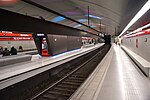Sagrera railway station (Catalan: Estació de la Sagrera, Spanish: Estación de la Sagrera) is a major through station under construction in the Barcelona districts of Sant Andreu and Sant Martí, in Catalonia, Spain. It is intended to serve as the central station for northern and eastern Barcelona, with Sants serving as the central station for southern and western Barcelona. Together with El Prat de Llobregat and Sants, currently the only high-speed rail stations in the Barcelona area, it will be on the Madrid–Barcelona high-speed rail line. It will also be on the conventional Barcelona–Cerbère and Barcelona–Mataró–Maçanet-Massanes railways. Once fully completed, it will be a major public transport hub, with dedicated stations on Barcelona Metro lines 4 and 9/10, as well as a bus station. The complex will be fully underground excepting for the station building, with two levels of platforms, accounting for a total of 18 railway tracks.The new station is part of a larger urban redevelopment project along the corridor formed by the railways accessing Barcelona from the north-east, which divides the districts of Sant Andreu and Sant Martí. This project includes the rebuilding of Sant Andreu Comtal railway station, to the north of Sagrera, and the construction of a 3.7-kilometre-long (2.3 mi) linear artificial park over the railways running on the corridor, which will be put underground. At an estimated cost of €2 billion, the project is funded and managed by Barcelona Sagrera Alta Velocitat (BSAV), a public partnership made up of the Spanish Ministry of Public Works and Transport, the Government of Catalonia and the Barcelona City Council.The idea of a new central station at this location has appeared on local transport projects since the late 1960s. Before being demolished in 2007 with the start of the previous works to the construction of the new station, a major goods station on the Barcelona–Cerbère railway, built between 1918 and 1922, had operated at the location. The groundbreaking ceremony for the new station took place on 21 June 2010, when the completion date was set for 2016. In July 2011, a 1,100 m2 (12,000 sq ft) Roman villa was found due to the station construction works. The Spanish Ministry of Public Works and Transport and the City Council announced in July 2013 that they had reached an agreement to modify the original project in order to reduce its cost. In June 2016, it was disclosed that the station works have remained suspended since early 2014 due to a corruption scandal involving one of the companies carrying out the works.









